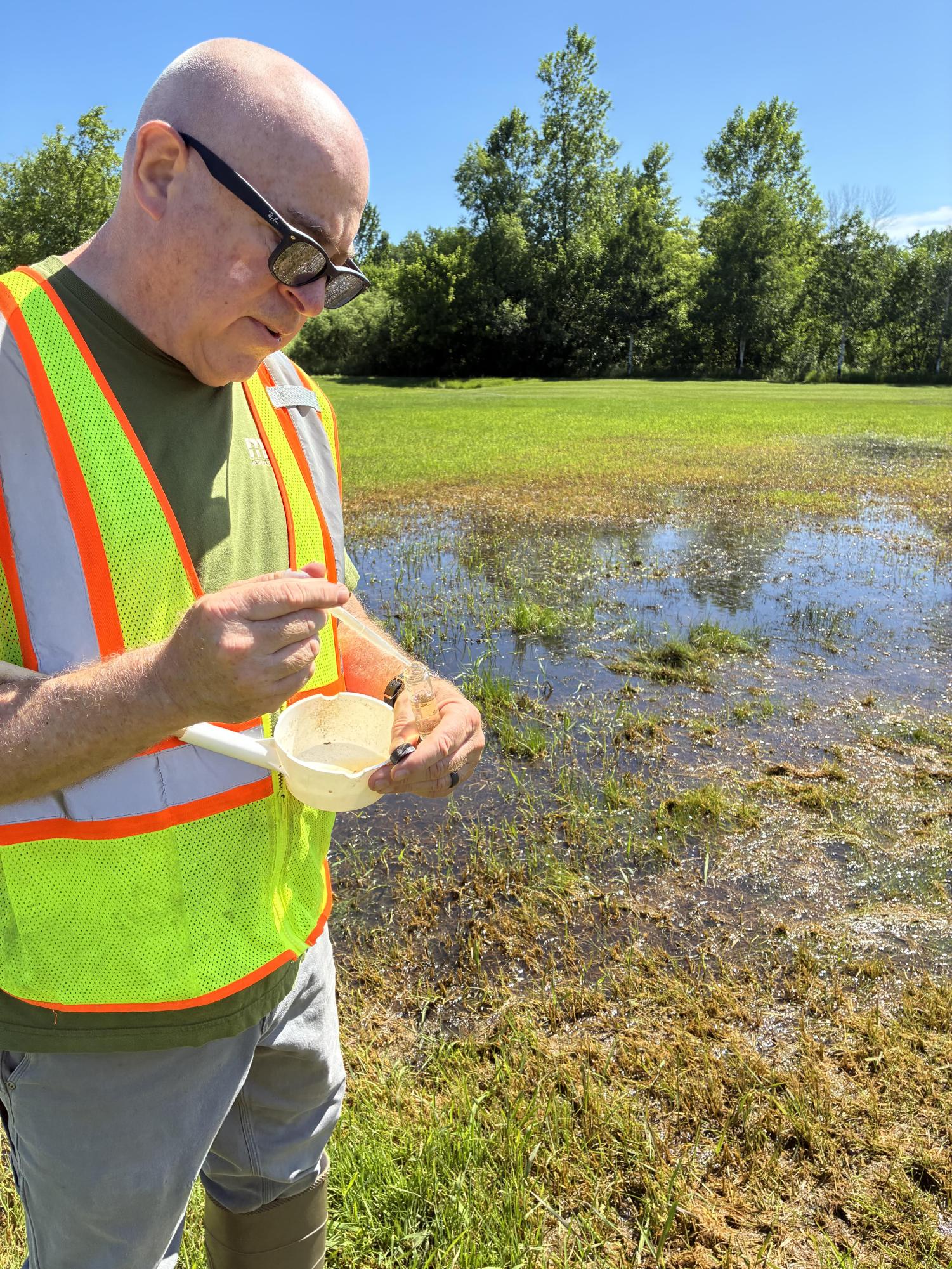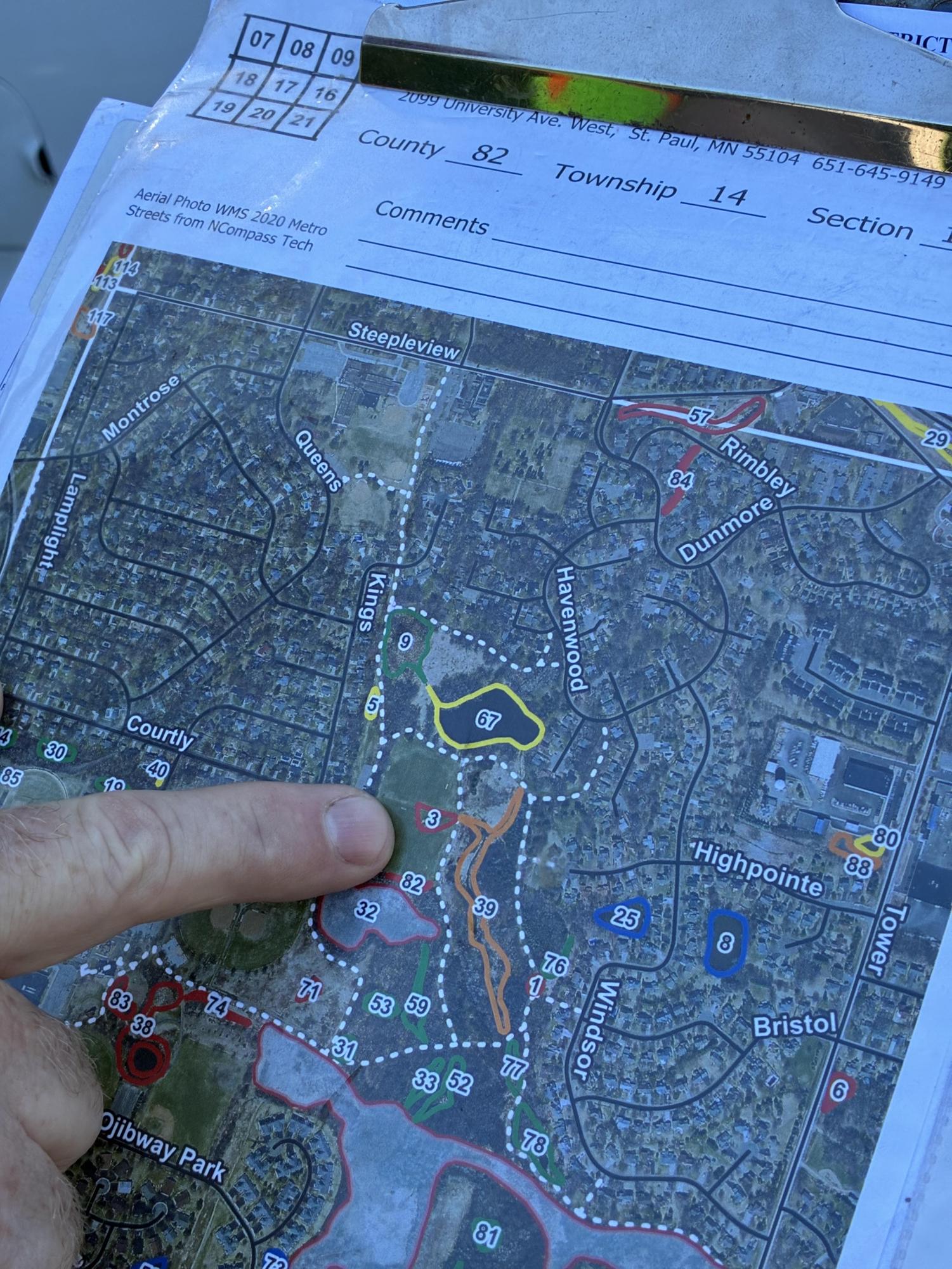
Doug Schultz
Steve Christensen examines a vial of mosquito larvae he just collected from a site near Ojibway Park in Woodbury.
WOODBURY, MN (WNN) – Just when you thought it was safe to go outside… cue the scary horror flick music.. TAKE COVER! THE MOSQUITOES ARE COMING!
After an unusually quiet spring, mosquito populations in the seven-county metro area are expected to increase rapidly in the next few days and reach peak levels in the next couple of weeks, say officials from the Metropolitan Mosquito Control District (MMCD). Woodbury is no exception.
Yes, you got it: Mosquito swarms, just in time to potentially buzz-kill your outdoor plans for the Fourth of July weekend.
But Woodbury resident and MMCD field worker Steve Christensen is doing everything he can to make sure that doesn’t happen. He and other members of the six-person east metro crew based in Oakdale, have been working feverishly in the past few days to treat the many known mosquito-breeding hot spots in their areas in an effort to keep mosquito numbers in check.
One of those spots is a grassy playing field in Ojibway Park. That’s where the Roundabout caught up with Christensen this week. “There are a couple of places in this field that really breed when they breed,” Christensen said.
In two low spots near a cricket pitch, water was standing ankle deep after heavy rainfall in the previous few days. After Christensen waded in and scooped up a dipper full of brackish water, sure enough, lots of little larvae could be seen wriggling about in his large, official-sized ladle.
Time to treat
In previous weeks he had counted only two or three larvae per dipper full, but this time there were at least 20, he said. That number was well above the established threshold for that spot for him to begin treating the site. With a bucket of crushed-up corn cobs coated with a bacterial agent in one hand, and a long-handled serving spoon in the other, Christensen walked in rows through the swampy grass and tossed out spoonfuls of the material at regular intervals. He treats each habitat area in this way to apply the right amount of material for each area based on its size.
Using maps of known breeding areas identified through decades of MMCD field work and data, Christensen will move on to other sites in the Woodbury area. When he finds a threshold amount of larvae in an area, he will treat the smaller areas by walking them or, for the larger areas, call in air support. Sites that are between three and eight acres are now often treated by using drones. The flying machines can lay down material more evenly and efficiently than a human – and more quickly, Christensen said. It takes a drone about 15 minutes to cover a two-and-a-half acre site that would take a fieldworker about 45 minutes by foot. “But it’s a resource issue, of course,” he acknowledged.
For even larger areas, in the tens of acres, where field crews find larvae in significant numbers, they will use helicopters to drop material.
Once hotspots are identified – where the threshold amount of larvae have emerged – it’s a race against time for MMCD field crews like Christensen’s. It can take as little as three or four days for the larvae to become adults and take flight – and take their first bite, he said.
So it’s critical to treat the areas while the larvae are still larvae, Christensen said. The most effective and safest way to control mosquito populations is to treat the larvae with the bacteria, called BTI. The larvae eat the bacteria, which – well, let’s just say it really messes with the larvae’s digestive system and they die.
Christensen, 63, left a career as a printing sales executive about 13 years ago to fulfill his passion for the outdoors, for helping people and to use his formal training in biosciences. MMCD met that need. “I feel like I’m doing a lot of good for a lot of people with this job,” he said. While on the job in Woodbury, he often gets greetings from people he knows.
Slow start
Several factors contributed to a slow start to mosquito season, according to Christensen and Alex Carlson, public affairs manager for MMCD. Cooler temps, and less rainfall, particularly cooler overnight temps and lower overflows in the Minnesota and Mississippi River basin, slowed mosquito activity to a crawl.

Cattail mosquitoes lay their eggs in the fall. Other mosquito species lay their eggs throughout the season from May to September. If they don’t get enough rain to hatch during the season, they will overwinter as eggs and hatch the following year. The last few springs, with warmer temps and more rainfall, saw earlier-than-normal hatches of mosquitoes, leading to the perception of delayed or non-existent activity for this year. July to September is typically the peak time for mosquitoes in Minnesota.
“Because there’s been so little activity, some of us have been waiting for the Armageddon,” Christensen joked. But things have changed with the recent rains and warmer weather. The day of reckoning has arrived.
Woodbury not major concern
If there can be good news when it comes to mosquitoes, it might be this: While it has its share of the pesky critters that do need to be controlled, Woodbury is not a particularly popular destination for mosquitoes looking to breed and expand their brood. Mosquitoes are fussy when it comes to their wetlands, you see.
Because Woodbury has developed primarily over formerly agricultural fields, most of the wetlands, ponds and lakes in the city are essentially man-made, and have been made to not hold mosquitoes.
There are a few places that offer natural, preferred habitat for various mosquito species, like the Tamarack Nature Preserve area northeast of the Target on Valley Creek Road, some cattail marshes near Battle Creek Regional Park, and an area south of Bailey Road near La Lake. Overall, there are hundreds of sites in Woodbury that MMCD regularly keeps an eye on during the season.

By contrast, the lowlands and marshes of northern Anoka County (think Oak Grove, Ham Lake, East Bethel) afford mosquitoes abundant watery habitat. Carver County is typically a hotspot for mosquitoes in the spring when the Minnesota River overflows its banks, encouraging species of floodwater mosquitoes to hatch. Northern Washington County’s marshes near Forest Lake and Scandia are also preferred areas for cattail mosquitoes. Last week, the areas with the highest mosquito counts were May Township in Washington County and Linwood Township in northern Anoka County, Carlson said.
So while those areas may get the most intensive treatments from MMCD crews, Woodbury does not go overlooked.
How To Prevent Mosquito Bites
Despite the best efforts of Christensen and other MMCD field workers, plenty of mosquitoes will get away this season to annoy Woodbury residents. While most mosquitoes are only pests, a few species do carry diseases, like West Nile virus and LaCrosse encephalitis, so it’s important to prevent mosquito bites and reduce mosquito breeding habitats around your home.
To prevent mosquito bites:
Avoid being outdoors at dusk and dawn, when mosquitoes are most active.
Use insect repellents that contain up to 30% DEET, lemon oil of eucalyptus or permethrin.
Wear protective clothing, such as long pants and long sleeves, when possible.
To reduce mosquito habitat:
Remove standing water around your home. Small pools of water that collect in old tires, tarps on boats, clogged gutters or even low spots in your yard can produce breeding mosquitoes.
Create barriers to mosquitoes by reducing overgrown shrubs and weeds and keeping grass cut shorter.
Finally, if you notice high levels of mosquito activity in your neighborhood, you can call MMCD to report it at 651-645-9149 or email [email protected].